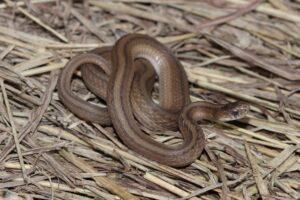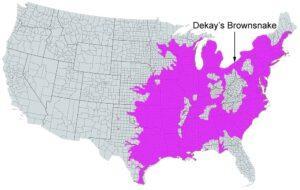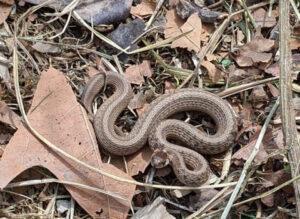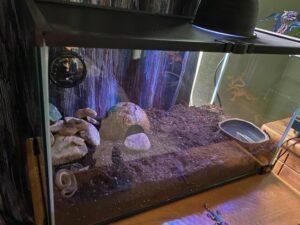DeKay’s brown snake is a small, thin, secretive snake native to North and Central America. Other common names of the species are De Kay’s brown snake, De Kay’s snake, and brown snake. It is named after American zoologist James Ellsworth De Kay, who collected the first specimen from Long Island, New York. Their small size, diet, and live-bearing capacity eliminating the need for egg incubation, make them a good pet.
Scientific Classifications
- Suborder:Serpentes
- Family:Colubridae
- Genus:Storeria
- Species:S. dekayi
Conservation Status
Description
Size
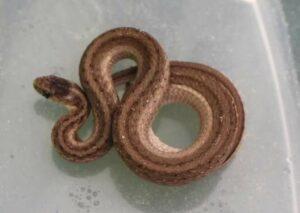
The average length of an adult of this species is 9-13 inches (23-33 cm). The largest recorded size is 19.4 inches (49 cm).
Color and Appearance
The colubrid is brown to gray dorsally with a lighter central stripe bordered with small black spots. The scales on this side of the body are keeled. The region between its eye and nostril has no (loreal) scale. There is a dark stripe below each eye. Ventrally, it is pink or lighter brown with tiny black dots at the end of the ventral scales.
Are They Dangerous to Humans
De Kay’s brown snake is docile and not known to bite. Even if it does so on rare occasions, it can’t pose any danger as it is non-venomous. When threatened, it flattens its head and neck to appear bigger and aggressive giving off a musky smell attributed to a secretion from the base of its tail.
Dekay’s Brown Snakes at a Glance
Distribution
The species can be found in Quebec, Southern Ontario, the eastern half of the US, Mexico, Honduras, Guatemala, and possibly, El Salvador. Specifically, it lives in most wetland and terrestrial habitats east of the Great Plains, from sea level to 4600 ft above.
Habitat
Preferring moist environments, the colubrid usually occurs near swamps and marshes, in river floodplains and moist woods, and occasionally near rocky hillsides.
Lifespan
The brown snake can live up to 7 years.
Predators
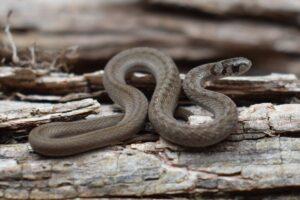
Big frogs, toads, American crows, blue jays, hawks, weasels, shrews, and domestic cats eat these snakes.
Diet
DeKay’s brown snake eats slugs, earthworms, and snails. In the southern part of its range, mainly earthworms form its diet, while in the northern part, it is slugs. Its jaws are such that they allow it to separate the shells from the snails that they have as food.
Reproduction
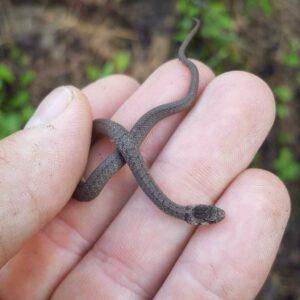
Viviparous (gives birth to live young)
The snake reaches sexual maturity at 2-3 years. It mates in spring after emerging from brumation (hibernation). Late summer sees the birth of 3-41 young to a female. The babies are born covered with a thin, transparent membrane and quickly separate from the mother. The color of the juveniles is similar to that of adults. Still, individuals can be lighter, optionally with a yellow ring around their necks.
Similar Species
Common Garter Snake (Thamnophis sirtalis): It has a prominent mid-dorsal stripe and a dorsolateral checkerboard pattern with spots occurring on more than a single scale. Its head is longer.
Copperhead (Agkistrodon contortrix): It is larger, thicker, venomous, and has an hourglass banding pattern. They have yellow cat-like eyes with vertical pupils, while the eyes of the brown snake are small and black with round pupils.
Smooth Earth Snake (Virginia valeriae): It also has small black spots on its dorsum, but its scales are smooth. Its head is more pointed.
Rough Earth Snake (Haldea striatula): It has keeled scales but lacks the black dorsal spots. Its head is more pointed.
Ring-necked Snake (Diadophis punctatus): It has smooth scales. It is uniformly gray to almost black with a distinctive red, yellow, or yellow-orange band on its neck.
Red-bellied Snake (Storeria occipitomaculata): It has a reddish underside and 3 light spots across the neck.
Florida Brownsnake (Storeria victa): It has a light neck band.
Care Sheet
Size of the Enclosure: A tank size of 10 gallons can comfortably house a full-size brown snake. Naturalistic terrariums with plenty of live plants and hides are best suited for it to showcase its natural behavior.
Temperature: This snake can be kept at room temperature, and a basking area is not required in its tank. Depending on individual choice, a basking spot can be added, but its temperature should not exceed 90°F.
Humidity: An average humidity of 40% works for the snake. However, it is best to raise the level to 60-65% when it starts shedding. A water bowl should be included in the cage.
Substrate: A mixture of a rainforest-type reptile substrate should be provided, like, aspen or coco-husk. Sand and newspapers should never be used.
Feeding: They should be fed several small weekly meals of earthworms, butterworms, black soldier fly larvae, canned silkworms, and mealworm pupae.
Source
sdherps.org, i.pinimg.com, sdherps.org, virginiaherpetologicalsociety.com, cdn.shopify.com, pbs.twimg.com, reddit.com

